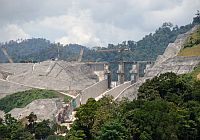Saturday, April 20, 2024
News and Views from the Global South
MALAYSIA: Power-Surplus Sarawak Funds Another New Dam
Anil Netto*
- Preliminary work on a 3 billion ringgit (875 million dollar) dam in Murum in the north Borneo state of Sarawak has put the spotlight on a controversial scheme to build a string of public-funded dams to provide cheap electricity for energy-intensive industries to the state.

The proposed Murum Dam is just 60 km upstream from the 2,400 Mw Bakun Dam (in the picture.) Credit: Raymond Abin/IPS
But while private firms may benefit from the dam construction work and cheap electricity, critics argue that the human cost, the financial burden and risk to the state and the public, and the environmental cost could be too high.
Sarawak Energy Berhad (SEB), 65 percent owned by the Sarawak state, officially informed the Malaysian stock exchange on Sep. 2 that the Murum Dam project had been awarded to China’s Three Gorges Project Corporation, which reportedly submitted the lowest bid among eight companies.
SEB also told the Malaysian stock exchange the same day that a ''detailed Environmental Impact Assessment has been submitted to the relevant authorities for final approval'' – which means that the project was awarded before the final approval of the detailed EIA was obtained.
While the state is using its resources to build the dams, about a thousand indigenous folk in the Murum Dam catchment area will lose their homeland. Most of these are Penan, amongst the last of the world’s hunter-gatherers, living near the Murum, Plieran and Danum rivers and tributaries.
Weng, a Penan, whose longhouse, traditional wooden houses, and ancestral land will be flooded, laments: ''The good things we ask for, they (the government) do not give. We ask for schools, clinics, but till now we have yet to see them. What we don't want, what is bad for us, that they provide – logging, oil palm plantations, acacia plantations …''
The haste to commence work on the dam leaves activists worried that there might not be proper consultation and inadequate work on the resettlement of one of the most marginalised and disenfranchised peoples in the country.
The experience of the problem-ridden 2,400 Mw Bakun Dam, whose reservoir area will cover 695 sq km, is hardly inspiring. The 8 billion ringgit (2.3 billion dollar) Bakun Dam is expected to be completed in June 2010 and start generating power in 2012.
Some 11,000 indigenous people – mainly Kenyah, Kayan, Lahanan, Ukit and Penan – were displaced and just over 9,000 of them were transferred to a resettlement scheme in Asap River from 1997. A delegation from the Malaysian Human Rights Commission, visiting the area in 2006, found shoddy housing, poor drainage and roads, delays and disputes in the compensation payment.
Critics point out that a large portion of the dams' catchment areas has already been degraded by massive plantation developments.
"The whole Bakun catchment is being destroyed by logging and plantation," points out Raymond Abin, programme development officer at the Borneo Resources Institute (Brimas), a group working closely with indigenous communities to monitor environmental and development issues. Forests have been logged to plant oil palm, pulp and wood tree plantations.
Moreover, the Murum Dam, just 60 km upstream from Bakun, lies in one of the three main catchment areas for Bakun.
''Has any work been done on cumulative impacts? How will all this affect the micro-climate or local climate, the hydrological regimes, the animal life of the area, already much devastated by the logging and plantation development?'' asked a Sarawak-based academic, who declined to be named.
''Indeed, how will Murum affect Bakun? Doesn't the public deserve to know the results of these cumulative impact assessments?'' the academic added.
The plan for the Murum Dam comes at a time when uncertainty hangs over what to do with all the electricity to be generated from the 205-metre high Bakun Dam. The original plan was to transmit the electricity via cables under the South China Sea to the peninsula, making it the world's longest undersea electricity transmission. But in 2001, the plan was changed to confine the supply to Sarawak and neighbouring Sabah state.
In 2005, however, the government decided it would not be cost effective to transmit electricity to Sabah because of the distance. The Cabinet decided the following year to once again channel Bakun's electricity to the peninsula even though the peninsula currently has a comfortable reserve capacity.
SEB entered into a "heads of agreement" this May to supply 3,000 Mw of electricity to national electricity corporation Tenaga Nasional Bhd in the peninsula from 2017 and another 5,000 Mw from 2021.
But these plans were thrown into uncertainty after Sime Darby, a government-linked corporation, worried about the plan's viability, pulled out in August from an understanding to lead the laying of 15 billion ringgit (4.4 billion dollar) undersea cables.
The electricity from the Bakun Dam will now be channelled to the aluminium smelter plants until the Murum Dam is ready, the Sarawak Energy managing director said in June. If and when the submarine cables are laid in the South China Sea, the electricity from Bakun would then be channelled to the peninsula.
(*This is the first of a two-part feature on a dam in power surplus Sarawak that is being built with public funds for private gain.)

 Print
Print



